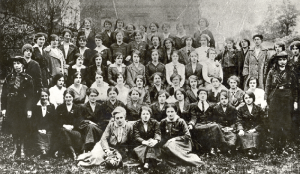Cumann na mBan by Joseph E.A. Connell Jr
Published in 20th-century / Contemporary History, Editorial, Issue 3 May/June2013, Revolutionary Period 1912-23, Volume 21
Above: Women of the National Aid Association—comprised of members of Cumann na mBan, Clan na Gael and the Irish Citizen Army—in the garden of Mr and Mrs Ely O’Carroll in the summer of 1916. In contrast with other organisations, Cumann na mBan preserved its position after the Rising and it is probably because of its existence that the struggle for independence continued. (Kilmainham Gaol)
The first meeting to discuss the foundation of Cumann na mBan was held on 25 November 1913, the same night as the first meeting of the Volunteers. Its first ‘official’ meeting was in Wynn’s Hotel on 2 April 1914. Agnes O’Farrelly was its first president and Mary Colum was one of its first organisers. The initial provisional committee consisted of O’Farrelly, Agnes MacNeill, Nancy O’Rahilly, Mary Colum, Jennie Wyse-Power, Louise Gavan-Duffy, Maire Tuohy and Maureen MacDonagh O’Mahoney. Its primary appeal was to women who could give time to the establishment of the organisation, women who did not need to work, but soon most were women who worked for a living—influenced by suffrage and labour issues.
Although it had its own command structures, the Cumann as a whole was subordinate to the Volunteers. At first some suffragettes distrusted the republican organisation. The Irish Citizen, a radical suffragette newspaper, called the Cumann na mBan members ‘slave women’ for supporting the Volunteers without a guarantee of suffrage. Most early members were wives, girlfriends or sisters of male nationalists whose interest in the success of the Rising was due to their family ties to it. They had less interest in agitating for the vote than did the editors of the Irish Citizen. Some praise the suffragists while painting nationalist women as puppets of the male nationalist organisations; however, women in the nationalist movement were able to make more of an impact on the men than suffragists, thanks to their relationship with male revolutionaries.
The women of Cumann na mBan used their unique position to increase the visibility of Irish women in the struggle for independence. Eventually, some of the more radical women joined Cumann na mBan, largely blunting suffragette criticism. Helena Molony spoke for many members when she responded that there could be no free women in an enslaved nation.
Following the split between John Redmond’s National Volunteers and the Irish Volunteers, the Cumann na mBan convention of November 1914 voted to support the minority Irish Volunteers led by Eoin MacNeill. Cumann na mBan issued a statement in the Irish Volunteer: ‘We came into being to advance the cause of Irish liberty . . . We feel bound to make the pronouncement that to urge or encourage Irish Volunteers to enlist in the British Army cannot, under any circumstances, be regarded as consistent with the work we have set ourselves to do.’
There were 43 affiliated branches before the Rising. In April 1916 Countess Markievicz was president and Sorcha MacMahon was secretary. Leaders included Elizabeth Bloxham, Winifred Carney, Áine Ceannt, Kathleen Clarke (president of the central branch), Nora Connolly (O’Brien), Margaret Dobbs, Louise Gavan-Duffy, Mrs Duffy Edwards, Agnes MacNeill, Una O’Brien, Nancy O’Rahilly, Niamh Plunkett, Jennie Wyse-Power and Maire Tuohy.
In 1916 there were three branches in Dublin: central, with headquarters at 25 Parnell Square; Inghinidhe na nÉireann, based at 6 Harcourt Street; and Columcill in Blackhall Place. In contrast with other organisations, the Cumann na mBan preserved its position after the Rising and it is probably because of its existence that the struggle for independence continued. The commitment of women before, during and after the Rising helped to bring the Irish nation to support the separatist movement. The widows of those executed in Kilmainham Gaol after the Rising did more to draw attention to the independence movement than any other group. The widows and female relatives of the executed and captives filled the voids in leadership and ensured that Irish independence did not die with their loved ones. HI
Joseph E.A. Connell is the author of Dublin in rebellion: a directory, 1913–1923 (Lilliput Press, 2006).
Further reading
E. Coyle, ‘The history of Cumann na mBan’, An Phoblacht (8 and 15 April 1933).
C. McCarthy, Cumann na mBan and the Irish Revolution (Cork, 2008).
C. Markievicz, ‘Cumann na mBan’, Cumann na mBan 11 (10) (1926).
















